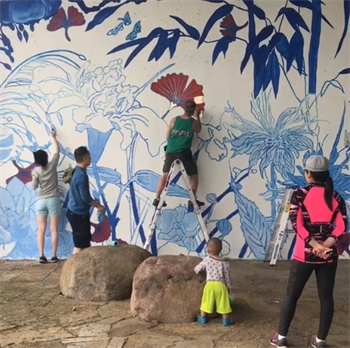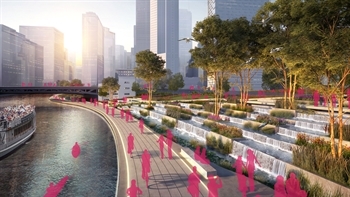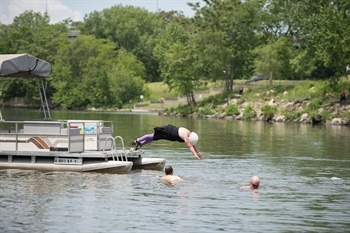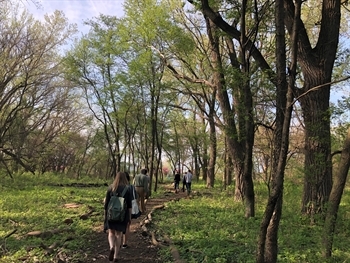In the two years since MPC released Our Great Rivers in partnership with Mayor Emanuel’s office, Friends of the Chicago River and others, we've been seeing big change on our region's waterways. Here's what you need to know.
Tweet this
Chicago's rivers are way cleaner than they used to be—I know, that's a very scientific term. They still have a ways to go, particularly in communities with legacy or active industry. There are many reasons why they're so much cleaner, but pretty much all the increase in activity along our rivers—from real estate development to bat habitats, murals to 5k runs—comes to back to cleaner rivers. You don't need to look much beyond the heart of downtown Chicago to see how much clean water can transform how we think about, invest in and relate to our rivers in an urban environment. The Riverwalk is a triumph, and it's changing the global perception of the city, as well as long-time residents' own opinions of their own home.
And yet, you also do need to look beyond the heart of downtown Chicago. In recent years, activity along our region's waterways has reached a bonified fever pitch. From wildly creative visions for a connected riverfront trail, to the first Native American Serpent Mound installation in centuries, to high-profile corporate investments upstream and downstream, there's been lots of exciting progress in the two years since MPC released "Our Great Rivers: A Vision for the Chicago, Calumet and Des Plaines rivers" in partnership with the City of Chicago, Friends of the Chicago River, the Chicago Metropolitan Agency for Planning and Ross Barney Architects. Our Great Rivers presents a vision of Chicago's rivers as inviting, productive and living—a vision we inch closer to every day... and a lot of it is somewhere other than the heart of the city.
Most of this amazing progress hasn't yet been covered in local news outlets. But these powerful stories are sure to inform, inspire and encourage you to get out to the water. MPC staff are proud to have been involved in many of these, but happier still that there's so much happening that we have very little do do with. Here's MPC's take on the Top 10 rivers achievements since 2016 you need to know:
1. Communities are activating the riverfronts.

A new mural at Ping Tom Park
The Chicago Community Trust is currently funding 10 community-led riverfront planning and activation projects. Projects tackle arts and culture, sustainability, economic development and public health, and are taking place on all three rivers. The Trust will be announcing the projects chosen for the second round of Our Great Rivers funding in the coming months. In addition to projects being funded through the Trust, local communities and governments are working on riverfront planning and improvements through CMAP's Local Technical Assistance program, the Chi-Cal Rivers grant and more.
In the Calumet region, more sections of the Cal-Sag Trail are being built, and the newest sections are now open for use. On the North Branch of the Chicago River ground has broken on the 312 RiverRun—a 1,000-foot-long, curving bridge that extends a recreational path between Addison St. and Irving Park Ave. Informed by the River Edge Ideas Lab (see #3), the Chicago Dept. of Transportation is conducting a preliminary feasibility assessment of extending a riverfront trail from where the Riverwalk ends at Lake Street to Ping Tom Park on the South Branch of the Chicago River. A coalition is forming around making improvements to the Des Plaines River Trail. Wherever you look, people are planning for riverfront access and trails! Advocacy organization Active Transportation Alliance is working on building local support for connected trails throughout the region.

SOM
A concept for waterfalls and a walking path at Congress St. created for the River Edge Ideas Lab.
Along with studying the possibility of extending a riverfront trail, the City of Chicago is updating the city's River Edge Design Guidelines, which will shape the coming decades of riverfront development. To inspire ideas and get public input, MPC and the Chicago Dept. of Planning and Development presented the River Edge Ideas Lab in 2017. Nine architecture and design firms created concepts for iconic destinations along the Chicago River. These designs and the public's feedback on them will influence the final design guidelines.
4. High-profile riverfront real estate development.
Developers are taking notice of the opportunities on the riverfronts. Riverfront office space demand is growing and new designs are embracing the rivers and making them the focus. New residential, commercial, and retail ventures are underway along the rivers, including Lettuce Entertain You, 150 N. Riverside, Wolf Point, 110 N. Wacker, the Old Post Office, REI, Riverline, The 78, and more.
Many parks and forest preserves bump up along the rivers. Public access to riverfront spaces for conservation or recreation is increasing, and the idea of our rivers as parks is catching on! Plans for the Wild Mile, an in-river park along the east side Goose Island, are underway and REI just announced a new riverfront location there that will feature canoe and kayak rentals. The Chicago Park District and the Forest Preserves of Cook County are actively exploring acquiring new riverfront land and improving access and programming at existing riverfront properties.
6. We're managing stormwater better.
Due to Chicago's combined sewer overflow system, excess rainfall can mean trouble for our rivers. The Metropolitan Water Reclamation District's McCook Reservoir, which can hold 3.5 billion gallons of stormwater, opened in Dec. 2017, and Phase II of the reservoir will open in 2029. On the Calumet River, where the Thornton Reservoir opened in 2015, there have been only a handful of combined sewer overflows in the last few years, compared to dozens annually before the system came online.
On the Calumet and Des Plaines, MPC is working with MWRD to develop water quality plans for specific stretches of river that will enable local governments and property owners to seek and secure federal and state funding for green infrastructure projects. Friends of the Chicago River, Faith in Place, the Space to Grow partnership, and many, many others are making similar investments in nature-based infrastructure as well.
All of this means the rivers are becoming cleaner than they have been in a long, long time. Which means...

Dan Wendt, Metropolitan Water Reclamation District
Diane Banta, of the National Park Service at the CalSag Plunge, dressed as Ursula the sea witch from the Little Mermaid
With the water quality of the rivers improving and serious conversations about controlling litter being led by Friends of the Chicago River, people are starting to consider swimming in the rivers. The Cal-Sag Plunge and the Friends of the Chicago River's Big Jump have municipal officials and civic leaders jumping into the Calumet and Chicago rivers to demonstrate that the water itself is no longer the barrier it once was! As you read this, an enthusiastic team is planning the first Chicago River open water swim!
Please note, there's still no sanctioned place to swim, with boat restrictions, ladders and other things we'll need to actually achieve this in a sustained way. But the fact that people are even talking - rather than joking - about it is in itself a sign of huge progress.
The City of Chicago Dept. of Planning and Development has embarked on its Industrial Corridor Modernization Initiative to update each of Chicago's 26 Industrial Corridors. Many of these corridors are located along the rivers, and each of them presents interesting and unique planning challenges. The North Branch Framework Plan called for improvements to green space along the river - such as the aforementioned Wild Mile—as well as incentives to bring more green industries to the area. The City is currently working on the Little Village Industrial Corridor and plans to begin work on the Pilsen corridor in Fall of 2018. There are additional industrial corridors elsewhere along the Calumet and Chicago rivers. We want these corridors to produce tax revenue and jobs, but also be spaces for community recreation and habitat along the rivers. That means the air, water and soil need to be clean, and that can be very complicated in the face of legacy or active industry. Hard questions need to be asked in partnership with adjacent communities and employers: If the environment isn't clean enough today for riverfront open space, is it dangerous to provide it? But if the long-term vision for our rivers is more open space and continuous riverfront trails, is it short-sighted not to work with industrial landowners now to secure it for the future?
9. Two Chicago Housing Authority developments are gaining new access to nearby riverfronts.

Adrian Smith + Gordon Gill Architecture
Walking through Beaubien Woods
On the North Branch of the Chicago River, the Lathrop Homes are being redeveloped and opened as mixed-income housing. Heartland Alliance and Related Midwest are working to engage existing residents to create an advisory council to activate the riverfront and provide long-term stewardship of the site. On the Little Calumet River, the Forest Preserves of Cook County and the Chicago Housing Authority are partnering to develop a master plan to increase access and connections between Beaubien Woods and the nearby Altgeld Gardens neighborhood (and surrounding neighborhoods). These two projects highlight the progress being made on creating equitable access to inviting rivers.
10. The rivers are seeing more action than ever!
Due to all of the improvements on this list and more, our more people are enjoying the rivers in new and exciting ways. Just in the past year, our rivers have hosted fishing events, canoeing and paddling events, clean-up days, arts events, a 5k run and a 10k bike ride, ecological boat tours, architecture & science class field trips, tours about the history of the Underground Railroad, movies-in-the-parks, rummage-sales, and more! These events have taken place on the Riverwalk and beyond, showing that there truly is a growing appetite for river activities!
What's Next?
It's amazing to see so much progress being made on our rivers—and there is still so much to be done! The next big thing relies on you. Get out and experience your rivers, get involved with one of the groups mentioned in this post, and help us make our rivers more inviting, productive, and living than ever!